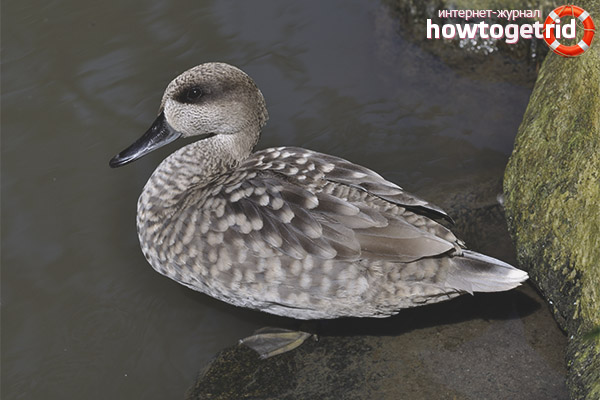The content of the article
The Marble Teal is a compact, interesting bird belonging to the Duck family. The elegant creature stands out favorably on the surface of the water, which attracts the attention of tourists and, unfortunately, hunters. That is why Russia entered the beautiful duck in the Red Book.
Appearance
Teal in size resembles other members of the family. It has a slightly elongated body (up to 450 mm) and a neck, an elongated beak. The wingspan reaches 600-700 mm (wing length up to 212 mm), and the weight of the bird barely exceeds half a kilogram. The tail is wedge-shaped and slightly rounded at the end. The bird is elegantly folded.
The color of the teal is unchanged throughout the year. Outwardly, it resembles an ordinary river duck, differing only in the manner of behavior, the principle of mating, etc. The bird got its name due to its truly marbled color - white (gray) speckled spots and spots spread throughout the body stand out on a beige-gray basis. On the teal wings there are no mirrors characteristic of waterfowl ducks. A transverse pattern is placed on the goiter. A brown spot (in males) and a bright spot (in females) spread around the eyes and to the back of the head. The cheeks and throat of the bird are light gray. The abdomen and underwing are whitish in color. The paws of the marble teal are also brown. The beak of males is colored in gray, and in females it is more pigmented black. Teal eyes are also dark.
The plumage of young animals is beige and more dull; speckles do not stand out.
On the occipital area, males also have elongated feathers in the form of a shortened crest. In females and young animals, such a “crown” is less noticeable.
Teal shedding occurs twice a year, with most contour feathers being updated. In early December, the feather cover is completely renewed, and by May there is a repeated replacement of feathers on the goiter, shoulder blades and neck. In drakes, unlike other representatives of the Utina family, a bright outfit is not formed during the mating season.
Behavior and lifestyle
Teals live mainly in stagnant water bodies and fresh or salt lakes with dense vegetation (coastal shrubs and trees, reeds, reeds, etc.). Birds build nests both on the ground and in hollows, alien nests, on trees. Representatives of the genus are often settled in small groups, while the distance between adjacent nests, as a rule, does not exceed a couple of meters.
The bird eats inhabitants of shallow reservoirs. Most often these are invertebrate organisms (crustaceans, insects, mollusks), sometimes small fish and fry are caught. Also, teal can feed on seeds and leaves of plants, local algae.
Breeding
During the mating season, individuals flock to small ponds or lakes with a muddy bottom and densely overgrown vegetation shores. As a rule, formed pairs already arrive at the nesting grounds, therefore mating games and male dominance are not observed among representatives of the genus.
Bird nests are covered with dense grass or foliage located near the bush. The construction for earthen masonry is simple - a shallow hole is prepared with a lining of dried grass and fluff. In the Volga River Delta, teals also lay their eggs in ready-made abandoned raven nests.
As a rule, up to 8-12 eggs slightly expanded with brown-red color are laid in the clutch.The female incubates them independently on average 25 days. The males of these birds, unlike other representatives, do not participate in incubation of masonry and rearing of young animals. With the offspring growing up, birds form colonies and leave their nests, flying away to feed on ponds and lakes.
Habitat and conservation status
Marble teal is considered a settled species of waterfowl. Wintering flocks are preferred in Pakestan, Iraq, Iran, Syria, Azerbaijan, and also not in the north of the African continent.
Marble teal has chosen the waters of the arid zone, which extends from the coast of the Mediterranean Sea to the Indus Valley and Central Asia. In Russia, birds are located in the Caspian region, as well as on the Volga River Delta, the lower reaches of the Agrakhansky Bay and the Terek River. True, the last nests were found only in the 80s. Rare bird populations were possible north of the main breeding zone. It is extremely rare for individual individuals to be seen flying in the Babayurt and Kizlyar regions of Dagestan.
The bird is endangered for many reasons. First of all, the natural habitat of the representatives of the genus is becoming poorer:
- The area of aridity of the territory is increasing.
- Snowy winters do not feed small ponds, lakes and swampy lowlands that are usual for birds.
- Less and less water bodies are overgrown with dense vegetation, where a shy bird can protect itself from predators and calmly nest.
- As a result of economic activity, saline and freshwater lakes are drained.
Also, poaching is often organized for the bird, and its eggs are collected uncontrollably during the nesting period. Often a marble teal gets into fishing nets, where it dies.
The teal marble was listed in the International Red Book, as the number of individuals on the globe is less than 50,000.
Interesting! Previously, these birds were identified as Anas river ducks, but later they identified representatives of the independent genus Marmaronetta.











Submit